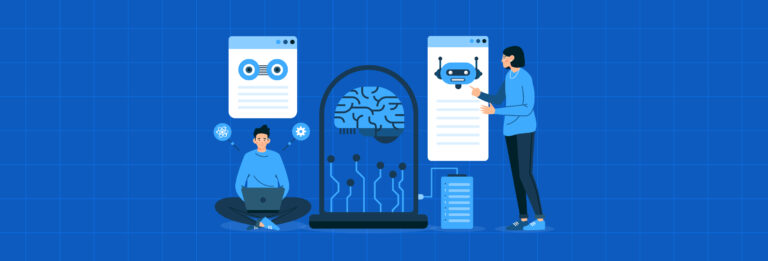ChatGPT is taking the world by storm, and users have been raving about its interactive capabilities and in-depth responses. This AI chatbot has dramatically transformed the way people engage with technology today. The best part! The technology is simple enough so all one has to know is how to give simple commands to receive detailed responses. No special training is required!
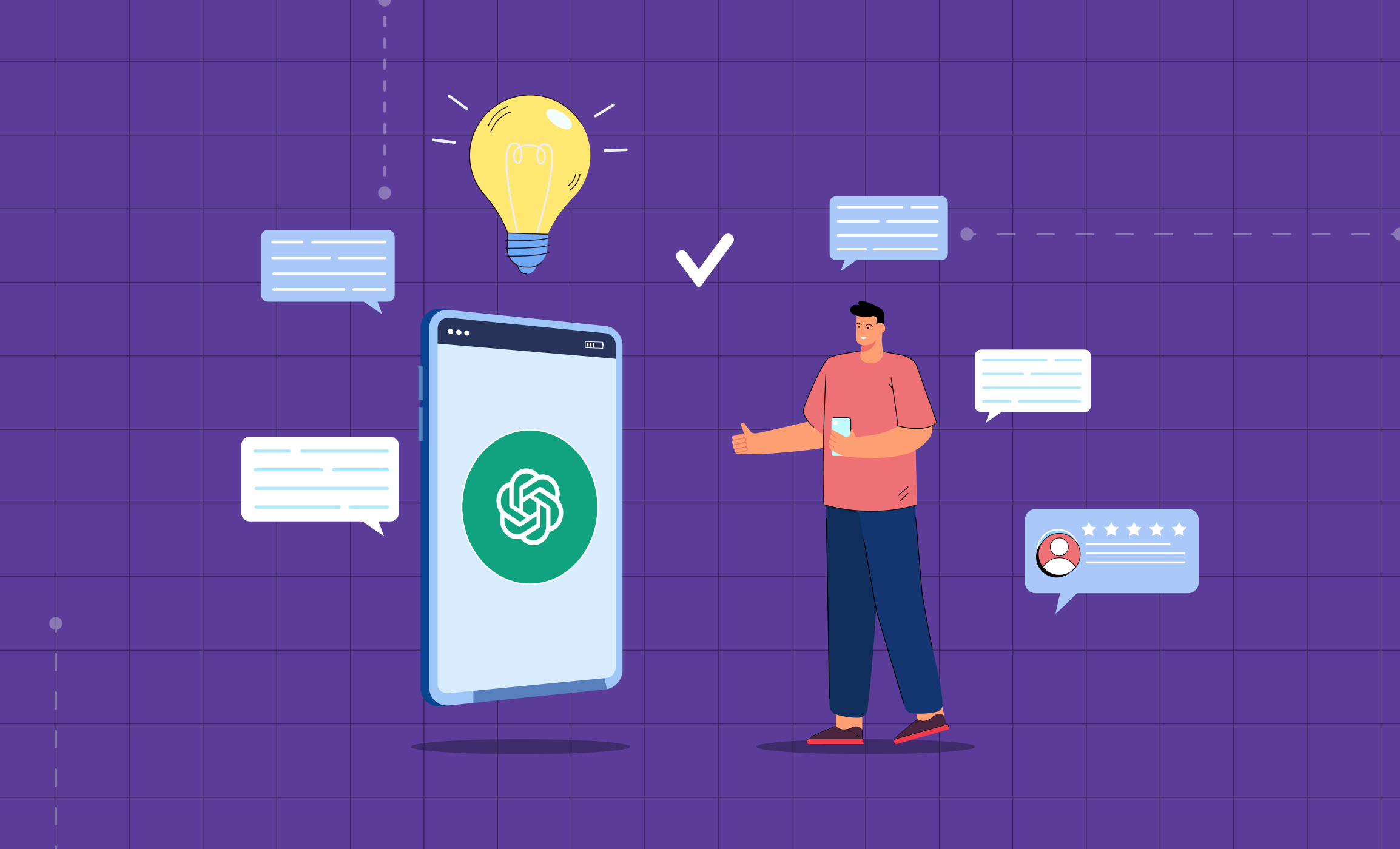
From developing complex app codes to explaining basic programming concepts and even recommending strategic initiatives, ChatGPT can almost answer everything. So, how can ChatGPT help in the sphere of Human Resources? Will it change the way organizations manage their employees? What advantages are there when using ChatGPT for HR purposes? We are going to answer all these questions below. But before diving in, let’s do a revision of what ChatGPT is and why it is so popular these days.
What is ChatGPT?
ChatGPT is an ‘Artificial Intelligence Chatbot’ created by OpenAI, an American artificial intelligence research laboratory. GPT stands for ‘Generative Pre-trained Transformer’.
It starts with OpenAI’s GPT 3.5 model and improves on it with a ‘big language model’ optimized with supervised reinforcement-based training. The bot has been programmed to engage in a conversational manner and provide thorough responses to user inquiries. ChatGPT can answer follow-up inquiries, admit mistakes, dispute faulty premises, and reject unsuitable requests, thanks to the dialogue style.
Some Pros and Cons of ChatGPT
GPT-3.5 (the most recent version) has an incredible level of performance. However, it comes with its own limitations and benefits. Let’s understand what are they:
Pros:
- Can generate human-like responses to a wide range of prompts.
- Can assist in customer service, language translation, and other applications.
- Can provide an accessible and engaging way to interact with technology.
- Can learn and adapt to new information and contexts.
- Can potentially revolutionize the way we communicate and interact with technology.
Cons:
- Can sometimes generate nonsensical or offensive responses.
- Can perpetuate biases present in training data.
- Does not have a true understanding of consciousness.
- Can require large amounts of computational power and data to train and run.
- Raises ethical and societal questions about the implications of AI on society.
Benefits of using ChatGPT for HR Processes:
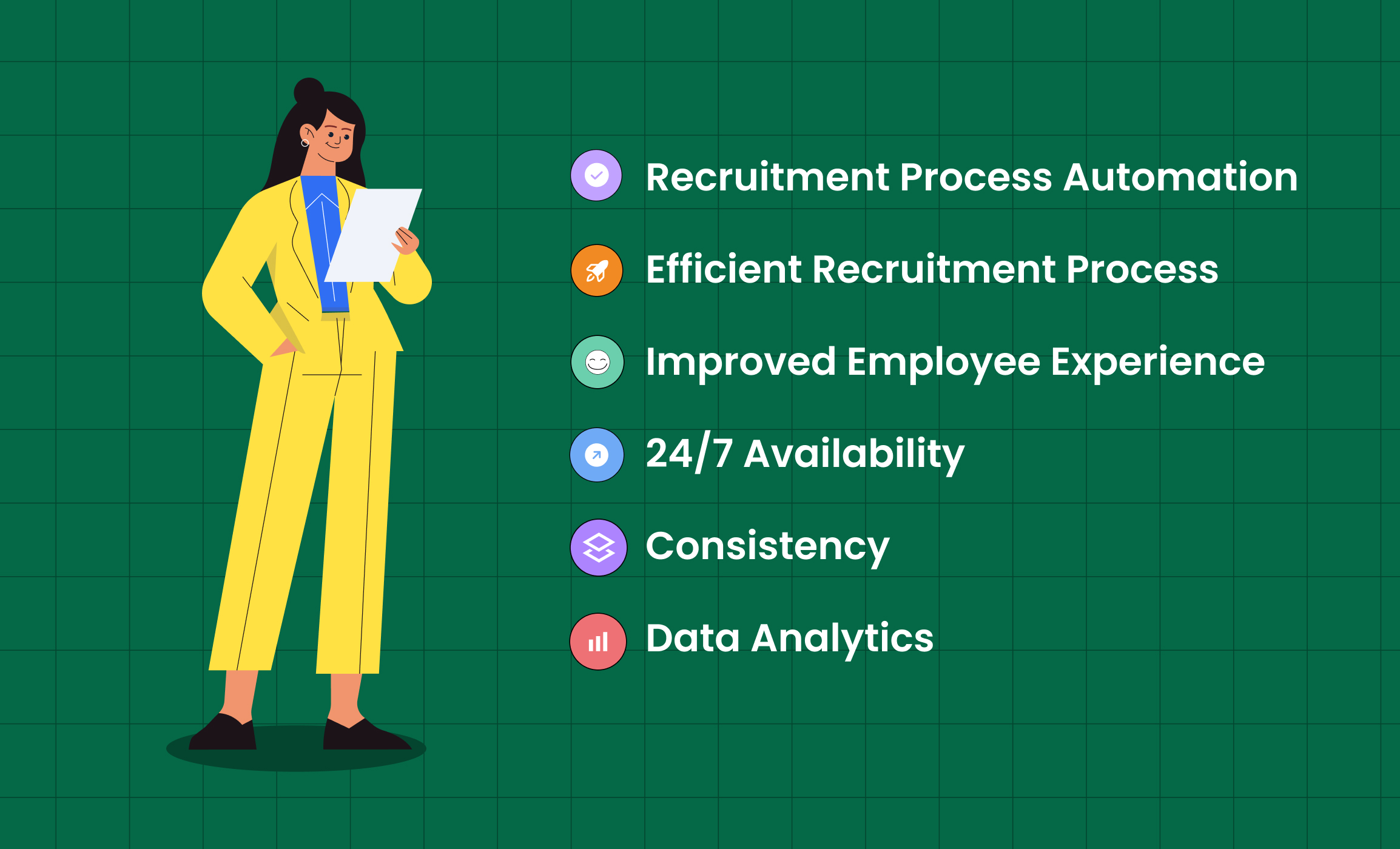
ChatGPT’s interactive nature allows it to effortlessly give exceptional employee support. As a result, the chatbot can handle the majority of employee inquiries, saving the HR team from answering the same questions again and over. ChatGPT implementation has various advantages, including increased cost-saving, employee engagement, easier management, enhanced insights, and more. The chatbot provides employees with a virtual HR that they can access at any time of day and from any location.
Organizations are constantly looking for ways to streamline their processes and find a more efficient way to execute tasks. ChatGPT has the ability to provide a number of advantages to HR professionals. Here are a few of them:
 Recruitment Process Automation:
Recruitment Process Automation:
ChatGPT may be utilized to automate the recruitment process, saving HR professionals time and effort. Chatbots powered by ChatGPT are capable of engaging with candidates, answering frequently asked questions, and even conducting preliminary interviews. This can assist HR departments in quickly screening and shortlisting prospects, decreasing the amount of time and resources required for recruiting.
 Efficient Recruitment Process:
Efficient Recruitment Process:
ChatGPT can be used to automate the recruitment process, which can save HR professionals time and effort. Chatbots powered by ChatGPT can engage with candidates, answer frequently asked questions, and even conduct preliminary interviews. This can help HR departments to screen and shortlist candidates quickly, reducing the amount of time and resources required for recruitment.
 Improved Employee Experience:
Improved Employee Experience:
ChatGPT can help employees with questions and issues. This includes responding to inquiries about employee perks, payroll, and corporate policies. Chatbots can also give employees access to learning and development materials, boosting the employee experience and engagement.
 24/7 Availability:
24/7 Availability:
ChatGPT can be available 24 hours a day, 7 days a week to provide help to employees. This can help to improve response times for employee queries, ensuring that employees get help as soon as they need it. This is especially handy for employees who operate in different time zones or have pressing questions outside of usual business hours.
 Consistency:
Consistency:
ChatGPT may respond to employee inquiries in a consistent manner, ensuring that employees receive the same information regardless of who they are dealing with. This can help to limit the possibility of misinterpretation and ensure that staff understands corporate policies and procedures.
 Data Analytics:
Data Analytics:
ChatGPT can be used to collect data on employee queries and concerns. This data may be utilized to detect patterns and trends, which can assist HR departments in improving their procedures and identifying areas where employees may want more assistance or training.
ChatGPT for Recruitment:
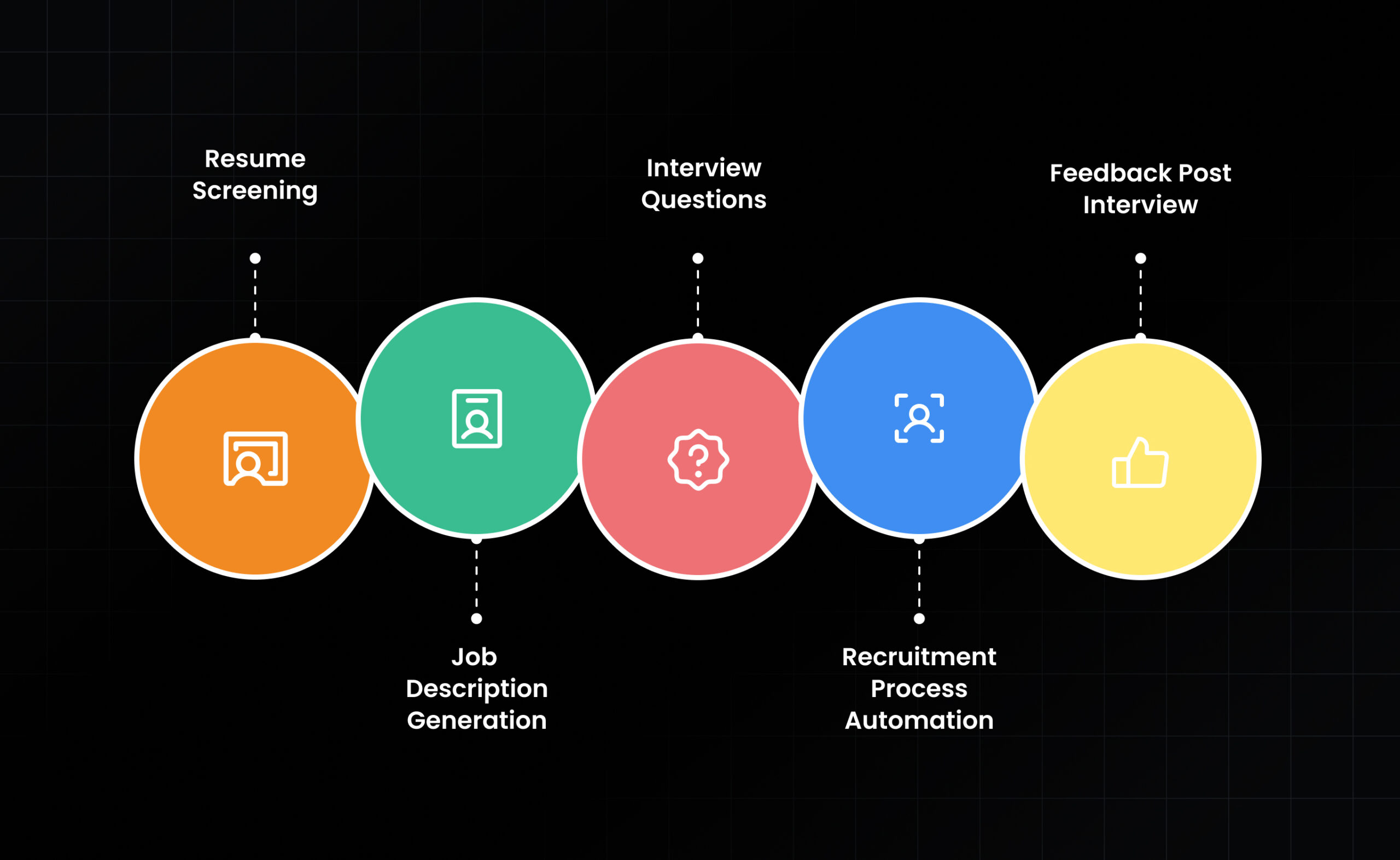
Businesses now are ready to invest in the right technology to find the best talent in the most innovative ways possible. And, AI is playing a significant role in helping businesses find just the talent they need. Another way ChatGPT is helping businesses is through efficient recruitment and smooth onboarding.
First, let’s understand how it is changing the landscape of recruitment:
 Resume Screening:
Resume Screening:
With this technology, you may analyze resumes and find people that meet specified qualities and competencies. This can save recruiters time while increasing the number of competent candidates considered for a post. Chat GPT can also be used to analyze job descriptions and match them with resumes, enabling recruiters in finding the best candidate for the job.
 Job Description Generation:
Job Description Generation:
With ChatGPT, you may create distinctive and effective job descriptions that accurately reflect the needed skills and qualities for a position. This can help to attract more eligible candidates and guarantee that the position is filled with the finest available individuals.
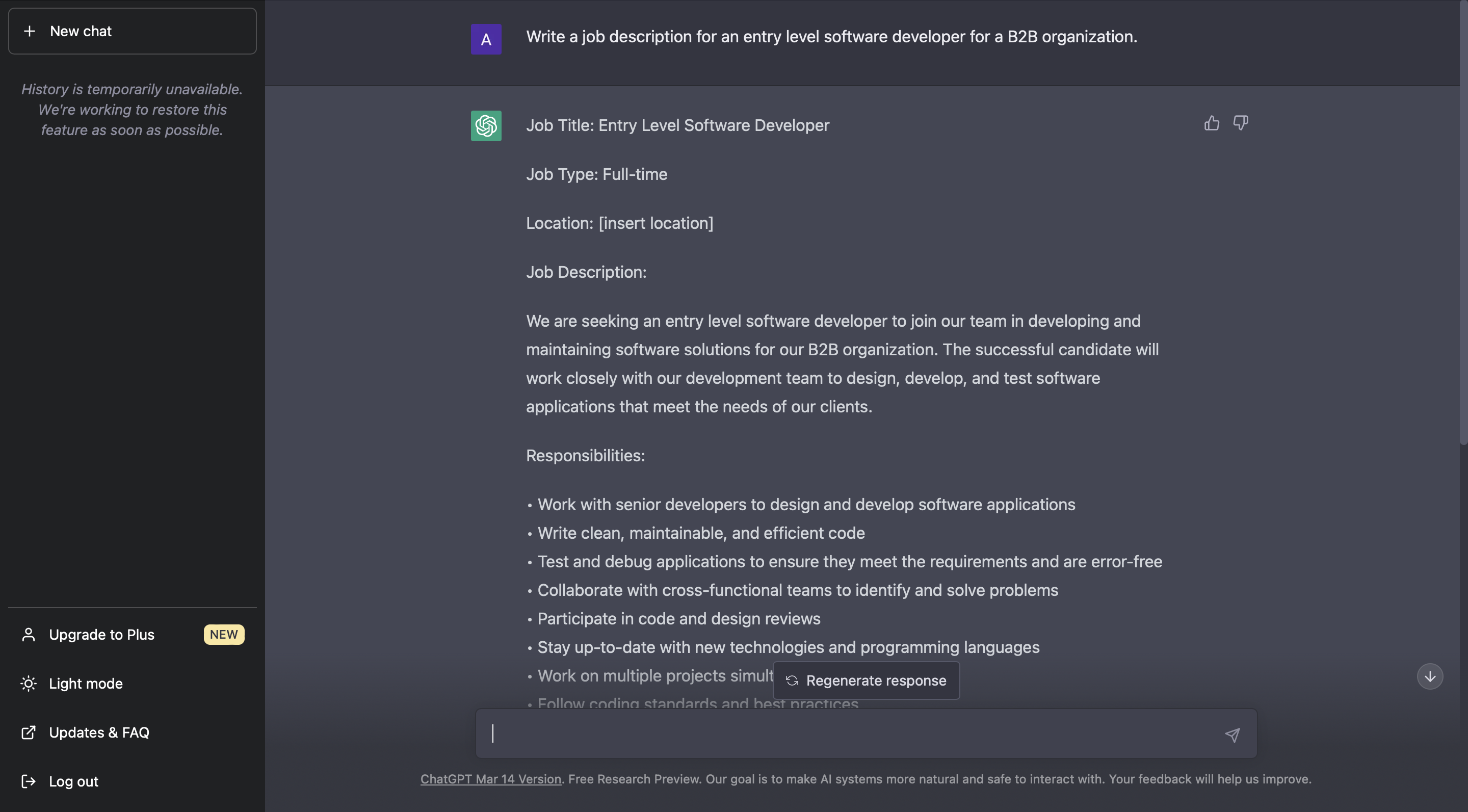
 Interview Questions:
Interview Questions:
ChatGPT can be used to generate interview questions matched to the candidate’s specific position and qualifications, allowing recruiters to ask relevant and interesting questions during the interview.
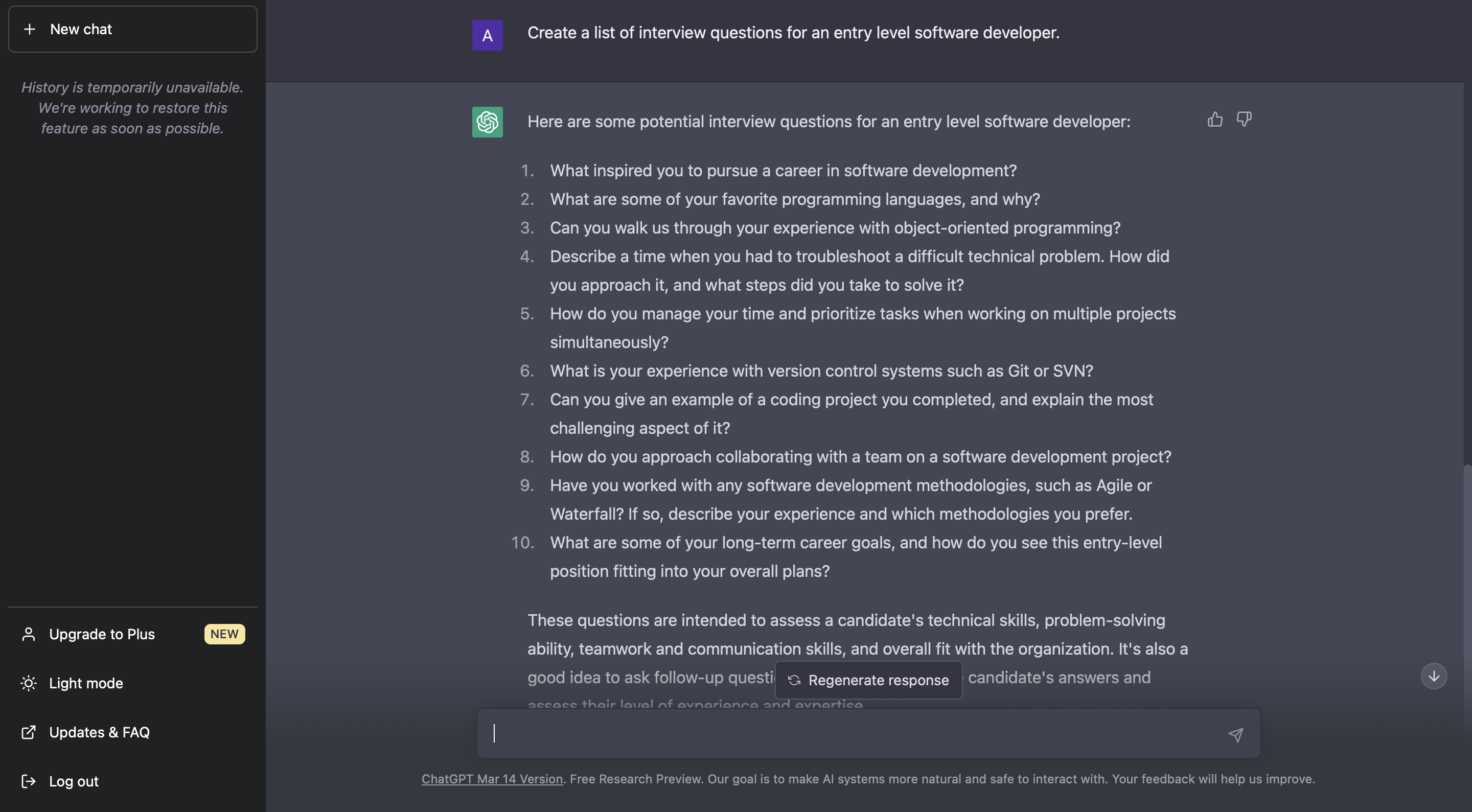
 Recruitment Process Automation:
Recruitment Process Automation:
ChatGPT can answer candidates’ questions about the job, the firm, and the selection procedure. This can assist in simplifying the recruitment process by presenting candidates with all of the necessary information in a timely and effective manner. This tool can also be used to give candidates automated reminders about interviews and other recruiting-related activities, which can assist keep the hiring process on track.
 Feedback Post Interview:
Feedback Post Interview:
ChatGPT can also be used to provide feedback on candidates’ resumes and interview performance, allowing them to enhance their chances of being successful in future job applications and interviews. This can also assist HR managers to discover areas of improvement in the recruitment process and improve the candidate experience.
ChatGPT for Hiring:

After a job description has been developed, the possibilities for using ChatGPT in the hiring process are endless. Automation of aspects of the hiring process is one of the most prominent applications of ChatGPT in HR.
When resumes are sent, ChatGPT can be used to screen them. AI might be used to analyze resumes and produce a summary of the most important information, such as the candidate’s skills, qualifications, and experience.
ChatGPT would need to be trained with a dataset of applications and job descriptions in order to maximize the benefits of resume screening. It would then be able to match resumes to job requirements and select the best candidates.
After all, resumes have been reviewed and compared, ChatGPT will be able to offer them in an organized style for HR employees to analyze and compare.
ChatGPT can be used to conduct the first interviews once a list of candidates has been generated. The AI can be configured to ask specific questions and analyze the responses of the candidates.
The candidate’s skills, experience, and appropriateness for the post can then be summarized via ChatGPT. These summaries can help to limit the number of candidates that must be interviewed in person, making the hiring process more efficient.
ChatGPT for Employee Onboarding:
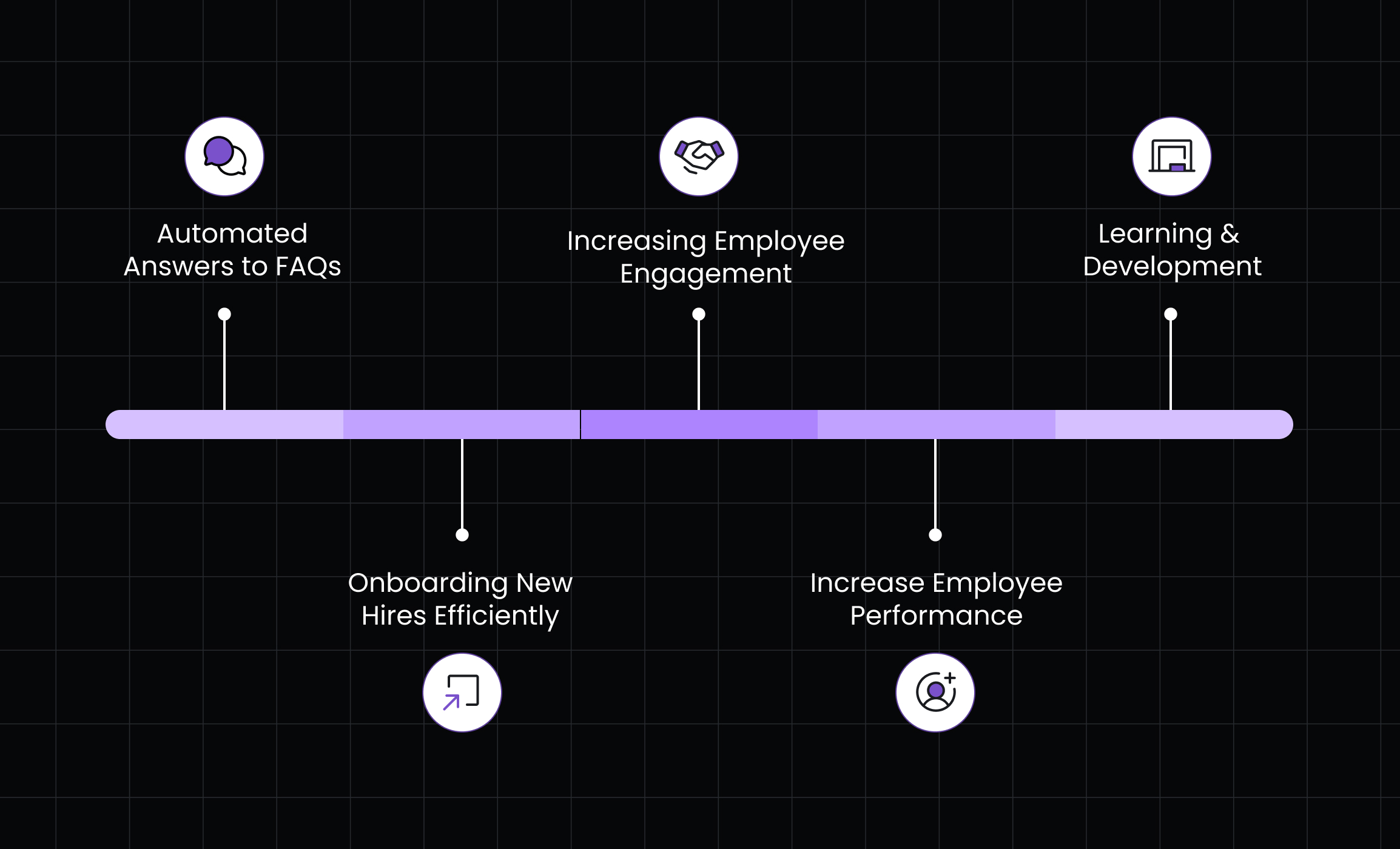
There’s little doubt that ChatGPT is removing the most time-consuming and mundane duties from HR’s plate and transforming them into a more conversational experience for the candidate. Now, onboarding is one of the most crucial stages in an employee’s lifecycle, and recruiters cannot afford to overlook it. Let’s take a look at how using ChatGPT for HR processes is helping in creating a memorable onboarding experience:
 Automated Answers to FAQs:
Automated Answers to FAQs:
ChatGPT’s algorithm can deliver automated responses to frequently requested employee questions (FAQs). This can save HR professionals time and effort, allowing them to concentrate on more important and strategy-oriented duties.
 Onboarding New Hires Efficiently:
Onboarding New Hires Efficiently:
ChatGPT can be used to provide new recruits with onboarding information such as corporate policies, practices, processes, and work culture. This contributes to a more quick and easy onboarding process, allowing new workers to feel incorporated into the company’s values and culture.
 Increasing Employee Engagement:
Increasing Employee Engagement:
ChatGPT is readily integrated with a company’s feedback system, allowing HR officials to collect employee feedback via surveys and other means. ChatGPT can provide a communication channel for employees to ask questions, and stay up-to-date on company news and events. The AI bot can also monitor employee departure patterns and track performance, giving HR professionals insights into employee engagement levels.
 Increasing Employee Performance:
Increasing Employee Performance:
By producing proposals, clarifying project processes, and creating press releases, ChatGPT can help improve employee performance remarkably. This can help HR workers focus on more strategic duties by saving time on quick and monotonous chores.
 Learning & Development:
Learning & Development:
ChatGPT may easily be used to alter your employees’ learning and development experience. Employees can get customized and on-demand learning resources via the interactive chatbot. For example, if an employee requests information on a specific topic, ChatGPT may respond with relevant details as well as links to related articles, podcasts, or other learning materials. ChatGPT can serve as a mentor or virtual tutor to employees, advising them on how to address a problem or assisting them in studying the subject matter.
It should be noted that the usefulness of ChatGPT in terms of L&D is dependent on how it is used and incorporated into a company’s existing training and development programs.
ChatGPT for HRs is just a tool, it cannot replace human recruiters, but it is a powerful technology that can help recruiters make recruitment and onboarding processes more efficient, accurate, and personalized.
GPT-3 x Leena AI
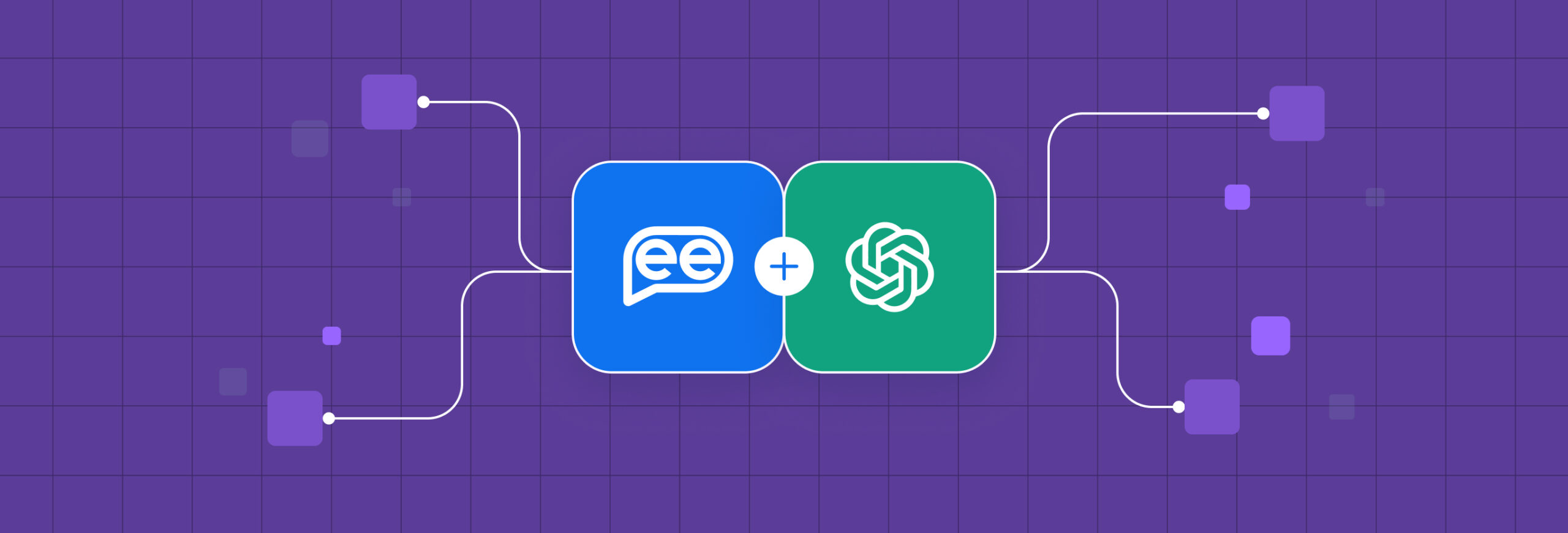
Leena AI, already a pioneer in the field of HR virtual assistant, has successfully launched its integration with GPT-3, which is the backbone of ChatGPT. With this integration in place, any query that is triggered will hit the first level of defense i.e. the Leena AI NLP. The second level will be shifted from Leena AI intelligent search to Leena AI integration with GPT-3 to reduce the number of unanswered queries. This integration promises to improve the overall end-user experience of interacting with Leena AI.
Leena AI’s aim is to empower enterprises to provide a delightful employee experience. Along with offering impeccable data security, Leena AI uses BERT, T5-3B, MiniLM, USE, and Roberta to create an efficient LLM model for a great conversational AI experience.
Leena AI uses cutting-edge technology and is truly made for enterprises. Transforming experience across all employee touchpoints, Leena AI enables enterprises to stay ahead of the curve.
Our integration with GPT3 includes:
- Enhancing Leena AI’s capability to answer in a more human-like manner by generating more data sets to train Leena AI’s language model and improving the overall end-user experience.
- Enhancing language translation by feeding more conversational language data in our models and catering to more languages at scale.
- Creating Leena AI’s own LLM that will allow our customers to choose between continuing with the Leena AI intelligent search, Leena AI integration with GPT-3, or Leena AI’s own LLM. To support both enterprise customers and customers who are looking for deployment on a private cloud.
- Reducing the implementation time by half to go live for our customers.
- Improving internal manual processes, assisting and guiding all employees in their learning and development, collaborating across departments and levels, and resolving common troubleshooting issues.
What is the future of AI in HR?
Significant advancements in AI and HR are anticipated in the upcoming years. Hyper-personalization is one of the trends, where AI will offer employees tailored HR experiences including feedback, well-being support, and development advice. Predictive analytics is a different trend, where AI will be utilized to make data-driven decisions, spot patterns, and anticipate future workforce requirements.
A lot of HR and administrative work will also be automated by AI, freeing up HR experts to concentrate on more strategic initiatives. AI will offer individualized engagement recommendations and collect employee input in employee engagement. By addressing unconscious biases and offering assistance to both employees and employers, AI is also anticipated to contribute to the promotion of diversity, equity, and inclusion.
Finally, AI will promote employee well-being by providing instant access to mental health resources, work-life balance programs, and personalized health recommendations.
Conclusion
Conversational GPT and other types of AI are shaping the future of recruiting. By automating repetitive activities and enhancing the overall process, ChatGPT for HR is transforming the human resource landscape. But, while ChatGPT is still in its early stages, it is certain that similar technology will change the hiring and employment market in the near future.
While this tool is extremely beneficial to work professionals, you should not rely only on it for all aspects of hiring and onboarding.
Finally, no AI tool can take over the human touch of recruiting, therefore utilize ChatGPT carefully.
Explore the Leena AI x GPT-3
Schedule a demo todayFrequently Asked Questions
What makes ChatGPT different from other chatbots?
GPT-3.5 (the most recent version) has an incredible level of performance. The chatbot is proficient in processing and generating both spoken and written languages. It offers rapid processing of complex data. It is highly sensitive and prohibits its users from making any inappropriate inquiries or asking for information about any difficult topics. Its lightning-fast text recognition capabilities can recognize any language. This allows for the identification and marking of specific modes of communication. As a result, potentially hazardous internet content may be detected and dealt with more effectively. Lastly, it provides detailed explanations, can even recall what it has previously said, and correct itself if necessary.
How can HRs use ChatGPT?
ChatGPT can be used by HR professionals in several ways, right from recruiting, onboarding, training, performance management, employee engagement, and compliance. When ChatGPT is integrated with an HR management system, it can be a powerful tool for automating monotonous daily tasks.
How are chatbots used in recruitment?
AI-based chatbots can be used to streamline the process of recruiting candidates at scale. Recruiters can generate job descriptions, create basic screening questions for the interview as well as rate the candidate’s response. AI chatbots can help in improving the candidate selection processes while also removing any human biases.
Can ChatGPT replace HR professionals?
ChatGPT is a technology and not a solution. The chatbot holds the potential to offer more HR capabilities, however, it does not promise to completely replace the human touch.
What about using chatGPT to improve other HR processes?
HR departments may now use AI solutions such as ChatGPT to improve their operations and increase efficiency. ChatGPT can be a valuable tool for HR managers in a variety of ways, such as automating monotonous work, giving real-time support to employees, and improving the overall employee experience.
Are there any potential challenges to using ChatGPT in HR?
ChatGPT makes choices based on the data it has been trained on, and if the data is biased, the system is prone to producing biased suggestions. Additionally, ChatGPT can not fully comprehend the intricacies of human speech, which may result in misunderstandings or misinterpretations.



